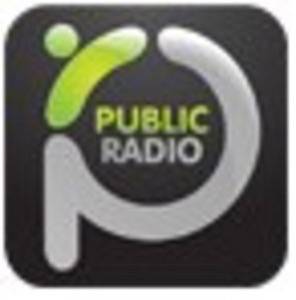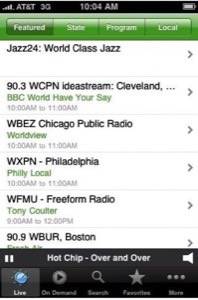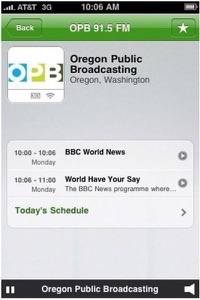Some newspapers scrambling to survive the internet condemn websites like Google News and the Huffington Post. Aggregators, they say, need to pay for the right to point to a newspaper’s site. Public radio stations, on the other hand, face competition from the internet as well and are just as competitive between themselves as they are collaborative. Somehow, they’ve responded differently to new media. There may be no better example of that than an iPhone application built by several large public radio organizations and called Public Radio Player. The team behind the app launched a major new release this morning.

The application aggregates live streaming and recorded radio broadcasts from across the US, displays their current and planned content schedules and now offers a search function that stretches across all those different types of content: live streams, podcasts and text show descriptions. It’s a free app and the organization that makes it hosts almost nothing on its own servers. The end result is a remarkable user experience that ought to be an inspiration for old media of every kind. It isn’t perfect, but it’s getting better fast.
The app was made by a non-profit organization called Public Radio Exchange (PRX). PRX was founded and is run by Jake Shapiro, a man who used to be an associate director at Harvard’s Berkman Center for Internet and Society. Shapiro used to produce an NPR radio show with Christopher Lyndon and before that he was one of the first tinkerers with web distribution of music for his band Two Ton Shoe.

Two Ton Shoe didn’t find a lot of success in the United States, but thanks to the long tail of the web Shapiro says they somehow found a big fan base in Korea. The band toured there and Korean bands have covered some of their songs. “I’m a Korean rock star,” Shapiro says, “and I believe there’s a ‘Korea’ out there for everybody.”
About a year ago Shapiro says he called around all the major players in public radio and argued that they had a unique opportunity in the iPhone platform if they could collaborate and create a really strong offering. An organization called American Public Media decided to contribute the work they had done so far on their own iPhone app to Shapiro’s project and NPR and Public Radio International agreed to lend their support to what would become the Public Radio Tuner, today renamed the Public Radio Player.
Funding Local Radio on the iPhone
Public Radio Player could facilitate that long tail experience for obscure local public radio content by making it far more available on the iPhone. But PaidContent’s Rafat Ali worries that by freeing radio listeners all the more from their local radio station, the Player could sever the loyalty and fund raising connections that keep public radio alive.

To that concern Shapiro has two interesting responses. First, he says that survey data shows most users prefer listening to their local stations on the app, along with a variety of favorites from elsewhere.
Even more interesting is the project’s collaboration with Cluetrain Manifesto co-author Doc Searls. Searls is at Harvard’s Berkman Center now, developing a framework for what’s being called Vendor Relationship Management (VRM) – a customer-based response to the business paradigm of Customer Relationship Management (CRM). The VRM project and Shapiro’s PRX are developing ways for Public Radio Player users to track what they listen to on the player and make financial contributions to the radio stations they’ve consumed from the most.
Shapiro says that part of the project faces a major roadblock from Apple. Though Apple introduced in-application payments last month, the feature is only available to paid apps (Public Radio Player is free) and charitable contributions through the iPhone are strictly prohibited. They can’t even be talked about, Shapiro says, because Apple doesn’t want to deal with the possibility of charity scams, there’s tax complications, the platform’s standard 30% fee for payments isn’t tenable in a non-profit context and Apple has no financial incentive to solve this sticky complex of problems.
For now the app is funded by a grant from the Corporation for Public Broadcasting. That funding is up for renewal this summer. Shapiro says that a second round of funding would be used to create “showcase apps that would break new ground and create new technology.” He says the company is particularly interested in technologies that represent a hybrid of digital and broadcast. “With radio,” he says, “there is still a tremendous amount of reach that you don’t want to give up on when you move into the digital space.”
Fixing the App
That hybrid paradigm is very well represented by the new version of the Public Radio Player. The previous version, called Public Radio Tuner, was one of the most popular free apps in the iPhone store but it didn’t really work that well. Radio streams got dropped a lot. That’s no longer a big problem with version 2.0.
The new version of the app tackles the problem of dropped streams by making the buffering settings much more sophisticated. Remember, the App doesn’t host any of the audio, it just points to the live streams or podcasts stored on public radio stations’ own servers. Project manager Matt MacDonald says the app now determines what kind of bandwidth the receiving phone has, then buffers the inbound stream accordingly before serving it up to listeners. The end result is a radically more usable radio app on wifi, 3G or Edge connections.
It’s still not perfect; this like every app is at the mercy of AT&T’s wireless network, but dropped streams appear to be much, much less frequent than they used to be. The interface sometimes hangs when loading menus, but Shapiro says that with the new release today bug fixes are a top priority and though crash reports are appearing infrequently, they are being closely watched. “Just shake the phone,” he jokes. “Then it will work better.”
More Than One Kind of Content
The new app brings a whole lot more radio to your iPhone. In addition to pointing to hundreds of radio streams, PRX has co-ordinated a number of different sources to pull show schedules down to be stored locally on your phone. “Scheduling data has been a big effort,” Shapiro says. “It never existed in one place and is still a moving target.”

A company called Public Interactive (recently acquired by NPR from Public Radio International) has a metadata tool that originally captured music playlists but now publishes radio show schedules as well. NPR and many radio stations also display schedules on their own websites. PRX aggregates all that data, stores it on your phone, syncs it with the radio stream links and then checks for changes each time you launch the Public Radio Player app.
Having the particular show that’s playing displayed along with a station name makes a very big difference in the user experience.
The 2.0 version of the app also includes support for “on demand” or podcast listening. Hundreds of podcasts are navigable by featured shows, category or alphabetically. Podcasts are integrated into some of the show schedules as well. When listening to a streaming station, you can view the rest of the day’s schedule and see what other shows will be broadcast later. Then you can choose to listen to previous recorded editions of those shows. It’s a pretty seamless experience.
Search is No Small Matter
The new search functionality integrates all of the above, letting you search for keywords or topics and finding both recorded and currently live shows that match your search. MacDonald says the company used an open source program called ThinkingSphynx on the back end, worked closely with the NPR API team and is still working on teaching local radio stations about the importance of standards-based content titling. Listening to streams and podcasts on iTunes or an iPod may not have been so difficult with incomplete file names, but show a radio station how broken its content looks in a dynamic iPhone directory and the message comes through loud and clear.
There have been other efforts to index all the public radio streams online; Public Radio Fan is the most notable and is more international, but is less sophisticated and is based on the desktop and browser. (After listening to some international broadcasts via Public Radio Fan it’s hard not to be a little disappointed with even Public Radio Player’s extensive but exclusively US menu.)
As a media technology, Public Radio Player offers a unique blend of content aggregation, focus on both real time and recorded content and extensive data integration on the back end. All on the iPhone. Its design and performance continue to improve. It’s a very impressive offering in terms of content delivery; if it can find a way to use the new platform it’s on to transcend the public radio paradigm of on-air pledge drives, that would really be remarkable, wouldn’t it?
Jake Shapiro says that offering Public Radio Player on other platforms, including a web interface, is a logical next step. You can follow the project’s progress on the Public Radio Player blog and download the application here.





















